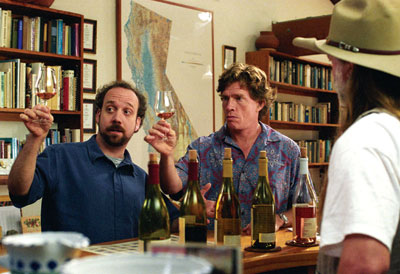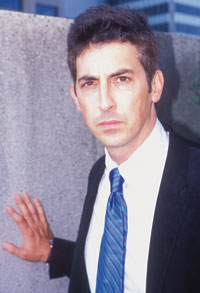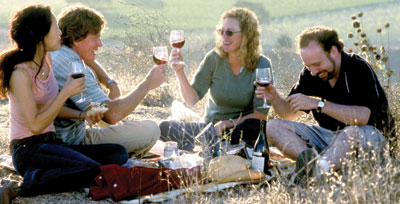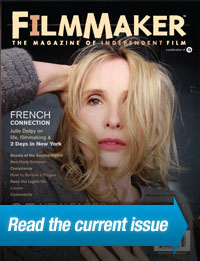IN VINO VERITAS
With Sideways, Alexander Payne abandons satire and his usual Midwestern milieu in favor of a tender comedy set in California wine country. It’s already being touted as a masterpiece. Matthew Ross speaks with Payne.
 |
| Paul Giamatti and Thomas Haden Church in Sideways. |
Given the ruthlessly clever tone of his first three features, one would not expect Alexander Payne to have the inclination — nor the patience — for a non-ironic story about the redemptive power of love. He is, after all, the man behind Citizen Ruth, Election and About Schmidt, all of which present a world in which nothing — women’s rights, sex between high school teachers and their students, the death of a spouse, starvation in Africa — is sacred. Remember that Citizen Ruth was billed as an “abortion comedy.”
With his latest effort, Sideways, a story of two friends’ weeklong road trip-cum-bachelor party through California wine country, Payne lets his guard down and succeeds brilliantly. The film finds its hero — and its heart — in Miles (Paul Giamatti), a never-was novelist, romantic failure and Pinot Noir enthusiast. Miles is unique among Payne’s protagonists in that his dissatisfaction with himself arises not from ignorance or fantasy but out of his awareness of his own failures. Payne acknowledges his character’s flaws but never holds him up to ridicule, and as Miles finally begins to slouch his way out of depression and towards romance with a likeminded soul, Payne has the nerve to let his story become less funny and even sincere.
In addition to being his most heartfelt, Sideways may also be his funniest. Much of that is due to the film’s pitch-perfect script, which Payne adapted with longtime collaborator Jim Taylor from Rex Pickett’s novel. Another factor is the hilarious performances, not least that of Thomas Haden Church, as Miles’s best friend Jack, a sex-obsessed, former soap star intent on getting his rocks off with as many local girls as possible before he ties the knot at the end of the week. It’s the classic odd-couple conceit, played for laughs and pathos without ever seeming self-conscious, trite or artificial.
Stylistically, Payne uses master shots, washed-out colors, unassuming camerawork and a jazz-laden score to evoke the classic American humanist comedies of the early ’70s, specifically the films of the great Hal Ashby.
Sideways, which premiered at Toronto and screened on closing night at the New York Film Festival, will be released by Fox Searchlight on October 20.
 |
| Alexander Payne. PHOTO: MIGUEL VILLALOBOS. |
Alexander Payne: Well, the producer — the fine producer I might add, Michael London — sent me the book in the summer of 1999, when I was traveling around with Election. I was flying back from the Edinburgh Film Festival when I finally got around to reading it. I got off the plane and ran to a pay phone and told my agent I had to make it, although I was committed to getting About Schmidt done first.
Filmmaker: What was it about Sideways that spoke to you?
Payne: The humanity of the characters. I know that really sounds kind of general, but I like to make movies that are just about people with flaws, unfulfilled desires, things like that. I liked the story, plus I like wine. The setting, the world, was very attractive to me. The novel’s also very, very specific. There’s almost a documentary feel to it, which also appealed to me.
Filmmaker: The tone of this film seems to be quite a departure from your other films, which are so satirical in nature. Would you agree with that assessment?
Payne: I don’t know. For me they’re all comedies. I’ve never referred to my work as satire. I’ve never called myself a satirist. I mean, I’m not trying to be willfully ignorant of the nature of my work, but when I approach a movie the issue is whether it’s going to be a good movie. If it’s funny, I read later that it’s a satire.
Filmmaker: However you describe it, would you say that Sideways does stand out from your other films?
Payne: Well, hopefully I’ve learned a bit more craft over the years. And I think there’s more craft in this film. And also, because the region’s so beautiful, I allowed the photography to be a lot more beautiful. And maybe this film gets a little bit more under the skin of the protagonists than in some of my previous work. I do know that it’s been my pleasantest filmmaking experience so far.
Filmmaker: How did you get the film off the ground?
|
But the key is — and I always tell this to other filmmakers — always write on spec. And keep control of your material as long as humanly possible. Because that way you get more say in how it’s made. And the nice thing with this is that I was really able to cast whomever I wanted. Which usually I do after the leads, but in this one it included the leads. I mean, I have no huge movie stars in it. Searchlight didn’t say boo. If I’d had bigger stars, I would have gotten a bigger budget with which to make the film. But I didn’t need a bigger budget.
Filmmaker: Can you talk about the budget?
Payne: It’s around $16 or $17 million. Somewhere in there.
Filmmaker: How long was the shoot?
Payne: A total of 54 days, including second unit. Principal photography was 49 days, and then 4 or 5 days of pick-ups, which involved some of the cast. I always direct that as well.
Filmmaker: You always manage to elicit strong performances from your actors. How did you decide on this specific cast, specifically the two leads.
 |
| Sandra Oh, Thomas Haden Church, Virginia Madsen and Paul Giamatti in Sideways. |
Payne: I just auditioned actors and then cast who I thought was most appropriate. And I did that regardless of how famous they were, obviously.
Filmmaker: How did you decide on casting Thomas Haden Church? His performance is fantastic.
Payne: What you’re responding to about him in the film is what I responded to in the audition. Tom is just unique. He kind of is that character. When I cast him, I had never seen Wings, his famous TV show. I’ve seen one episode since working with him. But he had auditioned for me both for Election and About Schmidt, and that left a positive impression. So I hauled his ass in for Sideways and thought, Well, this is the one that’s going to work for him.
Filmmaker: The style of this film, from the camera movement to the editing rhythm to the way music is used, has the feel of some of the classic American films of the ’70s.
Payne: Yeah, definitely. I’m a big fan of American films of that period, and so I would take that as a compliment because I think that’s the last decade when we had really, really human films told with a modern filmmaking vernacular. And you could say “fuck” and show breasts. And we had that in mind, even in the sound design. We’re not using the surrounds very much. The exaggerated statement I would make is that American movies in general were better when they were B&W and mono. But I’m pretty old-fashioned when it comes to filmmaking.
Filmmaker: I saw some Hal Ashby in there, if I’m not mistaken.
|
Filmmaker: What about The Landlord was so inspiring to you?
Payne: I think the photographic style. There’s something unique about the softness of the colors, about the way you can light things well but they’re not overly sharp and vivid. There’s just something more human about them, a more poetic way of capturing reality. That’s what I wanted. And it’s hard these days because labs have changed, film stocks have changed, lenses have changed, lines are sharper and the colors are more vivid. I don’t think films look as good now as they did 30 years ago.
Filmmaker: Was capturing that kind of style particularly challenging?
Payne: I think the biggest challenge for me was opening my heart to a love story and allowing the film to be beautiful. In my other films I purposely avoided beauty because there was a bleakness to the worlds that I was trying to capture. But when you’re in wine country and it’s harvest time and the weather’s so beautiful and you’re drinking wine all the time and there are beautiful women around... I was just more open to the more romantic elements of the film. I mean, the film is still tinged with a lot of loneliness and melancholy and loss, and those are perhaps elements of my previous films, certainly Election and About Schmidt. But there’s also a beauty to this one.
Filmmaker: A comic bleakness characterizes the first hour and a half of the movie, but that seems to give way arguably to a more hopeful tone, and a more serious one. Would you agree with that?
Payne: Well, I don’t really see things in terms of offering hope or not hope. It’s just about people. I think that Miles, Paul Giamatti’s character, when he gets that call from Mia [Virginia Madsen] and goes up to see her, I think he’s earned that. And the film doesn’t suggest what might happen afterwards. But, it is talking about the ability to finally open one’s heart after a long time of its having been closed, and what it takes to do that. I don’t think it’s either bleak or hopeful; it’s just kind of honest.
Filmmaker: You said that you wanted to make Sideways look like a ’70s film. In many ways your career is similar to one that some the ’70s directors had. How do you think you’ve been able to carve out this niche for yourself within a Hollywood system that seems generally resistant to the kind of author-driven films that you’ve been making?
Payne: A few reasons. One is, as Martin Scorsese posits in his documentary about American film, that the American film director is a smuggler — you work within a stated genre and then you smuggle in your ideas. I make comedies, and thank God I make comedies. If my films were straight-ahead dramas, I think I would have had less luck. But I’m always able to say to studio executives, “It’s funny and it will be a comedy, and you know comedy sells.”
Second, my films don’t cost much money and I really make a point of that. I really strive hard to make sure my films cost as little as they possibly can. I don’t care if my films are hits. I honestly don’t care. I just can’t afford for them to lose money. I need them to make back their negative costs, their bargaining costs, and one dollar. Then I can keep making films.
And third, I fight. When things come up at the studios, you have to fight and you can’t compromise. And you have to have faith that despite the scores and marketing data, you the filmmaker genuinely know more what a public wants than any of them do. You just have to have that faith, because you’re often a much more assiduous film watcher and film fan than many of them are. You have to have faith, and you have to fight. You can’t do anything, not one single thing that you don’t agree with.
But you know what? I think that for the first time in years and years it’s a very good time for independent filmmaking. Never mind that people say, “Oh, well this independent studio is gone and that one’s gone and this financing has dried up.” Studios will now finance independent filmmaking, and that’s what we need and that’s what we want.
I also think that the world’s pretty fucked right now. We’re in a pretty fucked-up time. We have awful, awful people in power and a lot of inhuman things going on. And I think as artists in general and filmmakers in particular we need to think about humanity. The audience is going to demand more political and humanistic filmmaking because we need that in movies; we need people to look to film for context and clues as to what’s going on, what’s really going on. It’s a really great time. And as much as I’ve despaired about the state of American cinema since basically about 1980, I have a really good feeling about it starting right now. And you know when the studios are burping up dirigibles like Catwoman and Van Helsing, which are tanking, that’s exactly the time when they need new blood.
I have to remain optimistic because I’m getting to make the films I want to make. I mean, I can’t decry American cinema right now because I’m getting to do what I want. And I’m not saying my films are great but I know that I’m in a good place.
Filmmaker: How long have you been this optimistic?
Payne: Oh, a couple of weeks.
VOD CALENDAR


 See the VOD Calendar →
See the VOD Calendar →


